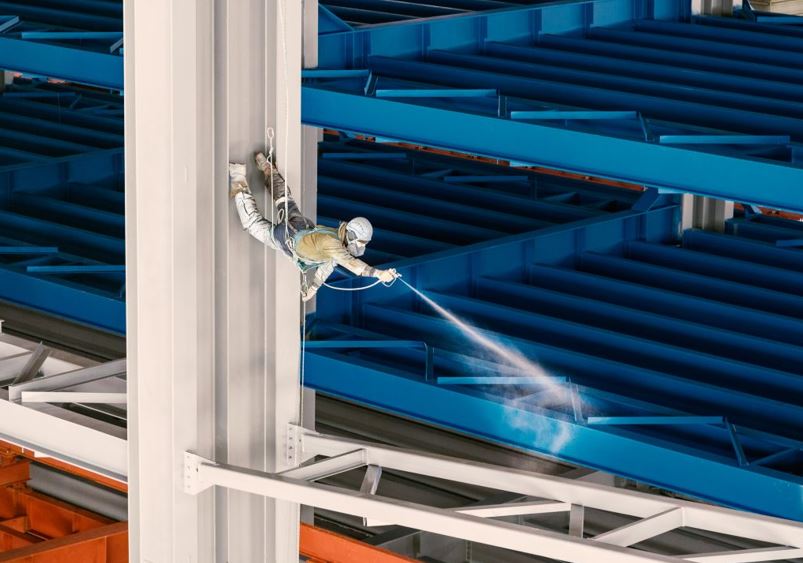If you are directly working with fire management strategy, every choice you make matters. Every single component that goes into the building or property impacts the safety of that structure.
And when it comes to fire-resistant coatings, most facility managers and in-house engineers would always include intumescent or cementitious coatings on their fireproofing list. Make sure to check the manufacturer’s label to ensure the coating meets the most current ASTM standards.

What are Intumescent and Cementitious Coatings?
Intumescent coating or paint is known for being passive at low temperatures but has a massive reaction to heat. That’s why it works as the building’s resistance against an occurrence of fire. Most paint will melt when exposed to heat, but these coatings have a different reaction.
During a fire, the temperature continuously increases, and the intumescent coating reacts by swelling and expanding up to the point that it creates a “char” layer that securely covers the steel. As it expands, it loses its density and therefore works as an insulator. It’s important to note that these coatings are different from heat resistant paint, which is designed to withstand high temperatures but not explicitly fire.
The cementitious coating, on the other hand, functions more straightforwardly. Its fire-resistance capability is due to the lightweight cement incorporated into the mixture.
Its cement-based composition of perlite, vermiculite, and lightweight aggregates combined with the heat-absorbing power of Portland cement makes this coating reach that appropriate fire-resistance level. With other additives thrown into the mix, its strength is further reinforced.
Intumescent vs. Cementitious Coatings
Both coatings are excellent choices for providing an additional coat of protection to a building against fire. But like most products, each of these products has its strengths and drawbacks. Understanding these can help you identify which is the better fit for your needs.
Pros and Cons of Intumescent Coating
Pros:
- It is aesthetically pleasing as it looks like your conventional paint.
- It has reliable all-around performance even in wet and moist conditions.
- It has low labor costs because a single coat is enough.
- Any trained painter can easily apply it.
- It requires minimal maintenance because it instantly forms a strong bond with the substrate sans the finish coat.
Cons:
- It requires additional surface preparation before application.
- It needs to have a primer and even a topcoat applied to steel.
- It is an expensive choice, with a square foot costing you $4 to $12.
Pros and Cons of Cementitious Coating
Pros:
- It is a more inexpensive option.
- It is lighter than conventional concrete but with the same fire-resistance capability.
- It is resistant to acid gases, chemicals, and chlorides.
Cons:
- It develops a space between the substrate and the coating as it dries, promoting corrosion.
- It is prone to cracking and spalling as it cools off after being exposed to burning temperatures.
- It is not aesthetically pleasing, and it requires several coats to achieve that flat, even look.
- It adds a substantial amount of weight to the building or structure.
Best Applications for Intumescent and Cementitious Coatings
Intumescent coatings are highly recommended for environments where extensive rain and constant moisture are a cause for concern.
As the facility manager, you can have the confidence that, despite the substrate being wet or moist most of the time, this kind of coating will adhere expertly and leave no room for cracks and peels. It locks out moisture effectively, so the wet environment would not affect its competence if it is exposed to fire.
Intumescent coatings also work well for climate-controlled settings. Wherever you are, whatever your weather conditions are, an intumescent layer would work as intended.
With cementitious coating, you may face certain challenges. This type of coating automatically creates a small gap from the substrate when it dries. No matter how thin, this separation allows for moisture to thrive and causes corrosion to the surface that the cementitious coating is supposed to protect.
Moreover, the constant exposure would escalate to stalling, peeling, and cracking of the coating, and if it loses its integrity, the coating won’t be as effective in case of a fire.
Cementation coatings are thus best for dry environments and surfaces that are not always observed, like highway structures, roof structures, and underwater structures.
Expert Advice
Both intumescent and cementitious coatings are effective and reliable passive fireproofing options. However, intumescent paint reigns supreme because of its additional versatility, overall appearance, and fireproofing effectiveness.
With advanced science integrated into it, you don’t have to worry about when and where to use it. On the other hand, if you simply need minimal fireproofing and if aesthetics is not a primary concern, then cementitious coatings are your best option.
Remember, regardless of which coating you choose, you need to adhere to the NFPA and IBC standards and the local guidelines. It would also be best to ask for advice from expert coating professionals to make sure you are 100% compliant.

